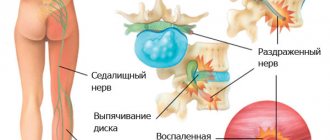Neurologist
SEMENOVA
Olga
5 years experience
neurologist, head of the office for diagnostics and treatment of cognitive disorders
Make an appointment
Polyneuropathies (polyneuropathies) are a group of pathologies affecting peripheral nerves. The clinical picture is determined by the form of the disease diagnosed in the patient. Specific signs are muscle weakness and atrophy, decreased tendon reflexes, sensory disturbances, and autonomic disorders. Treatment of polyneuropathy is carried out by a neurologist. The main task of the doctor is to determine the cause of the disease. Therapy is symptomatic.
Causes
The reasons leading to the development of polyneuropathy in patients are varied. Often, damage to nerve cells develops against the background of severe poisoning with methyl alcohol, arsenic or carbon monoxide. Similarly, axonal health can be affected by volatile compounds high in phosphorus.
In some cases, the symptoms of the pathology appear against the background of chronic intoxication of the human body, diphtheria, vitamin deficiency or diabetes mellitus. The disease can develop with uremia, liver cirrhosis, kidney damage, hypothyroidism or cancer. Long-term use by the patient of amiodarone, isoniazid or metronidazole can lead to the manifestation of polyneuropathy.
Kinds
Neurologists distinguish two types of polyneuropathies based on pathogenetic signs of damage to peripheral nerves - axonal and demyelinating. The first form of the disease affects the long, cylindrical extensions of nerve cells called axons. The second provokes the loss of myelin in myelinated nerve fibers. Late stages of axonal disorders are accompanied by demyelination. Primary demyelinating polyneuropathies are complicated by secondary damage to the cylindrical processes of nerve cells.
In the process of diagnosing and treating polyneuropathies, doctors may use other classifications of the disease. Based on the clinical picture, neurologists distinguish motor, sensory and autonomic polyneuropathies. In their pure form, these types of pathology are rare: most patients are diagnosed with damage to two or three types of nerve fibers (motor-sensory, sensory-vegetative, etc.).
Studying the etiology of the disease allows neurologists to identify hereditary, autoimmune, metabolic, nutritional, toxic and infectious-toxic polyneuropathies.
Prognosis with proper treatment
If therapy for this disorder was started on time and carried out in full, the prognosis for polyneuropathy is positive. However, with severe intoxication, the disease takes on a chronic form, which deprives the person of the chance for a full recovery.
However, even in such cases it is possible to minimize unpleasant consequences. To do this, you must always follow all the recommendations of your doctor. This usually comes down to the following rules:
- refusal of alcoholic beverages - alcohol negatively affects the functioning of nerve fibers;
- taking protective medications when working with toxic substances - neutralizes the harm to the nervous system;
- control of the dosage of medications taken - it is the uncontrolled use of medication that reduces the conductivity of nerve fibers;
- quality control of all food consumed - if you regularly eat some spoiled foods, polyneuropathy can return again;
- immediate treatment of viral and infectious diseases - prolonged exposure to pathogenic organisms negatively affects the functioning of nerve fibers and endings;
- Regular visits to the treating specialist - he will be able to identify pathogenic changes in the body at the initial stages.
Symptoms of pathology
During the examination of the patient, the neurologist identifies signs of damage to motor, sensory and autonomic fibers. The degree of involvement of these structures in the pathological process determines the clinical picture of the disease. Thus, when occupational polyneuropathy is detected in men and women, neurologists record sensory-vegetative symptoms (which are associated with regular fixation of muscles in a state of static tension).
The predominance of motor signs of pathology becomes the cause of the development of paresis of the upper and lower extremities. In the absence of treatment, the patient's individual muscle groups atrophy, including the respiratory ones (against the background of Guillain-Barré syndrome). Later, tendon reflexes decrease, and the person has difficulty performing basic tasks such as fastening buttons or tying shoelaces.
Sensory symptoms develop symmetrically, affecting the feet and hands of patients in the early stages. Sensitivity disorder manifests itself in different ways. Patients may experience tingling, burning, numbness, and pain. In the later stages of the disease, adults and children experience disturbances in the pain and temperature sensitivity of the skin.
Autonomic disorders are accompanied by dry skin and dysregulation of vascular tone. Over time, patients develop signs of tachycardia and unstable functioning of the gastrointestinal tract. Men may experience erectile dysfunction.
Treatment of polyneuropathy of the extremities with herbal infusions
It is possible to get rid of this disorder in the early stages with the help of traditional medicine. It must be borne in mind that such therapy cannot in any way replace medications. It can only be used as an aid to help speed up the appearance of results.
The most popular infusion recipes are:
- Mix bay leaf and fenugreek seeds in a ratio of 1 to 3. The mixture must be poured with a liter of boiling water, then leave for 2 hours. After this, you need to drink the resulting decoction throughout the day. This therapy not only helps restore the functioning of nerve endings, but also brings sugar levels back to normal.
- Mix a half-liter jar of vinegar with 100 grams of wild rosemary. This solution must be infused in a dark, cool place for 7 to 10 days. After this time, dilute a tablespoon of tincture with the same amount of water every evening and thoroughly treat your feet.
- Mix clover flowers with dried garlic, sage, goldenseal, cassia bark and black cohosh in equal parts. Every day, brew a spoonful of the mixture with a regular glass of boiling water and leave for 2 hours. After this, divide the broth into three equal parts and drink throughout the day.
Diagnostics
The primary symptoms of polyneuropathy are identified by a neurologist during the examination of the patient. The next stage of diagnosis is laboratory tests. A child or adult is prescribed general clinical and biochemical blood tests, genetic and immunological tests. In some cases, a biopsy specimen is taken from a peripheral nerve. Histological analysis of the obtained material will allow doctors to determine the nature of damage to the nerve fibers.
Electromyography remains the key hardware method for diagnosing polyneuropathy. During the procedure, doctors examine the bioelectric potentials of the patient's muscles. EMG allows you to assess the intensity of the pathological process and exclude other neurological diseases from the history of a child or adult.
Treatment
Therapy for hereditary forms of polyneuropathy is symptomatic. Autoimmune disorders are brought into remission. Diabetic, alcoholic and uremic types of pathology require a combination of drug therapy and exercise therapy. Against the background of diphtheria polyneuropathy, patients are prescribed artificial ventilation.
Modern pharmacology cannot offer people suffering from polyneuropathies drugs that effectively eliminate damage to the cylindrical processes of nerve cells or myelinated nerve fibers. Palliative therapy includes vitamin complexes and neurotrophic agents.
Treatment of porphyritic polyneuropathies involves the use of glucose and painkillers. In the demyelinating form of the disease, patients are prescribed membrane plasmapheresis, supplemented by immunoglobulin injections. If they are insufficiently effective, doctors use glucocorticosteroids - prednisolone or its analogues.
Treatment of diabetic polyneuropathy of the lower extremities is carried out not only by a neurologist - the patient needs to consult an endocrinologist. For severe pain, men and women receive tricyclic antidepressants, pregabalin and gabanetin.
The symptoms of toxic polyneuropathies become less obvious when contact of a child or adult with the toxin is excluded. In case of drug intoxication, the doctor adjusts the daily dose received by the patient.
Surgical intervention against the background of polyneuropathy is performed when there is deformation of the feet and the development of joint contractures. In this case, the patient will face a long period of rehabilitation. To treat uremic polyneuropathy, a child or adult may require a kidney transplant.
Classification
According to the generally accepted international classification of diseases ICD-10, diabetic polyneuropathy is assigned code G 63.2, E 10.4, E 11.4, E 12.4, E 13.4, E 14.4, depending on the type of lesion.
Symptoms of diabetic polyneuropathy directly depend on its type and stage.
At the moment, there are numerous manifestations of pathological changes that can be divided into main types.
Sensory polyneuropathy
With sensory diabetic polyneuropathy, sensory nerves are affected, which causes distorted sensations in the lower or upper extremities, and the face symmetrically.
The sensory form of polyneuropathy is characterized by:
- Hyperesthesia (increased sensitivity to irritants). Pathological changes in the nerves cause the transmission of false signals coming from the skin receptors to the brain. Result: goosebumps, chilliness, burning, tingling and even sudden pain.
- Inappropriate response to stimuli. Painful sensations occur with any external irritation of the skin (stroking, pinching). Also, with one stimulus, multiple sensations arise (bright light causes tinnitus, a certain smell and taste are felt).
- Reduced or completely absent sensitivity. Damaged areas of the nerve limit the transmission of information to the brain (socks and gloves syndrome). With tactile contact, a person feels gloves on his hands and socks on his feet.
Motor polyneuropathy
Motor polyneuropathy affects the motor nerves, which are responsible for transmitting signals from the brain to the muscles. The development of symptoms is gradual. Motor polyneuropathy manifests itself most clearly at night and during rest periods.
- Stability is lost while walking as a result of decreased sensitivity and muscle atrophy.
- Coordination of movements is impaired due to the inability to transmit signals from the vestibular apparatus to the brain through the affected cranial nerves.
- Joints lose mobility, begin to swell and become deformed as a result of fluctuations in sugar levels, microcirculation disorders and metabolic processes. Initially, the joints of the fingers of the lower and upper extremities are affected.
- There is the appearance of muscle weakness, a decrease in the strength of the hands and feet due to impaired blood circulation and innervation. The muscles swell, weaken, and their volume becomes smaller. Then their atrophy occurs.
Sensory-motor (distal) form of polyneuropathy
Sensorimotor (distal) polyneuropathy is characterized by a complete loss of sensitivity to temperature changes, external physical pressure, pain, etc. Severe acute pain in the legs, worsening at night, may also be present.
Further, the functioning of the musculoskeletal system is disrupted, bone deformation occurs, and muscular dystrophy occurs.
The skin becomes excessively dry, reddish in color, with age spots appearing. The work of the sweat glands stops.
The soles of the feet and the interdigital area in advanced cases of sensory-motor polyneuropathy are covered with ulcers that do not cause pain due to a lack of sensitivity. However, inflammatory processes can lead to limb amputation.
Diabetic polyneuropathy of the lower extremities
Typically, diabetic polyneuropathy most often affects the legs. At an early stage of damage to the lower extremities:
- there is a feeling of “goosebumps”;
- legs systematically go numb;
- there is pain in the feet and ankle joints, especially at night. Sometimes there is a burning sensation in the feet;
- sensitivity to pain and temperature changes decreases.
Editorial: Is a brain transplant possible?
With the further development of the disease, a pain syndrome appears, which decreases when walking, and is most clearly manifested in a state of rest, stress, overwork, and during sleep. Changing the position of the legs does not lead to a change in the nature of pain.
Diabetic polyneuropathy of the lower extremities leads to:
- to atrophy of the leg muscles;
- muscle flaccidity in the fingers and toes;
- redness or darkening of areas of the skin;
- thickening or thinning of the nail plates;
- development of osteoarthropathy of the foot: the ankle joint is deformed, the foot increases in transverse size, flat feet appear, the pulse in the affected area is not detected.








